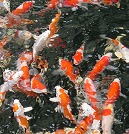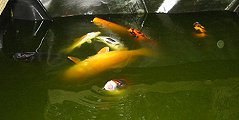Feeding fish in warm water is an interesting conundrum. To succeed you need a strong equilibrium between the fish, the water’s oxygen levels and the demand for it by beneficial bacteria (Equilibrium by luck or by design). The fish NEED a lot of food because they are burning a LOT of calories. The pond’s biological reduction system is optimized and working ferociously on fish wastes. Warmer water carries less oxygen. Still, in most ponds a natural balance is forged which can usually handle this. But there’s risk.
Feeding Koi a lot of food in the warm months is desirable, and it ensures good health and growth. But if you go too far, and overfeed them, the water quality will deteriorate and if you overfeed enough, there can be a sudden bloom of bacteria that will:
1. Cloud the water
2. Weaken or stress the fish
3. Consume much, if not all, of the available dissolved oxygen.

Don’t take this lightly, because even with your years of success, you can get into trouble. I did this one summer. I fed heavily and the fish were doing well. What I did not acknowledge was that my oxygen levels were TEETERING in the danger zone because of the ferocious use of oxygen by the fish, the feeding and the biological bacteria, and the warmth of the water. I went to net my favorite fish up, and she simply stroked out for lack of Oxygen in her peak metabolic condition and then compounded by warm water and the chase.
What Can You Do?
Well, waterfalls do a LOT to contribute oxygen to the scenario. So breathe a sigh of relief if you have a robust set of falls. Additional water pumping with a spray bar can increase oxygen. If the pond is in filtered sunlight or only gets baked for part of the day, it will be cooler, and contain more oxygen. Shade cloth is employed seasonally on some ponds in the hot Southwest. “Feeding hard”, but being alert is an ingredient for success. And finally, intermittent water changes can simultaneously contribute to a coler ambient temperature and reduce the fuels used by damaging bacterial blooms.
Water Change Routine During Feeding Season:
10% per week
20% every 2 weeks
30% every 3 weeks
I am a lazy Koi keeper, so I run water to my ponds all day every day via a drip irrigation system which can replace between 12 and 100 gallons a day. I never drain and fill water change anymore.






